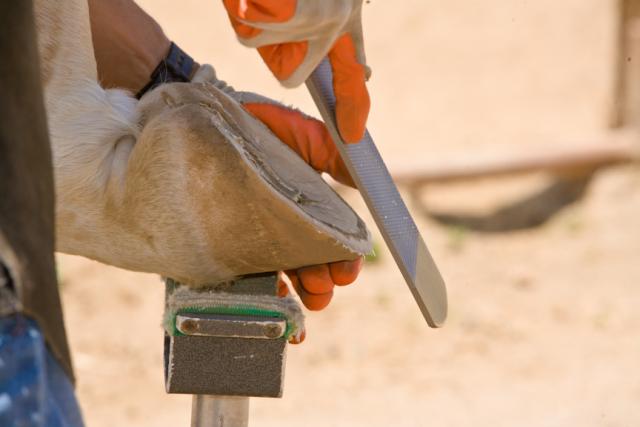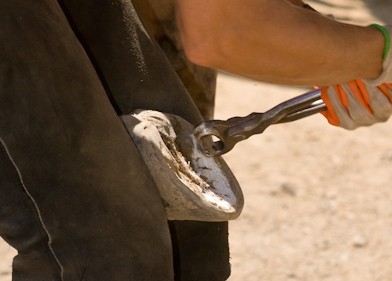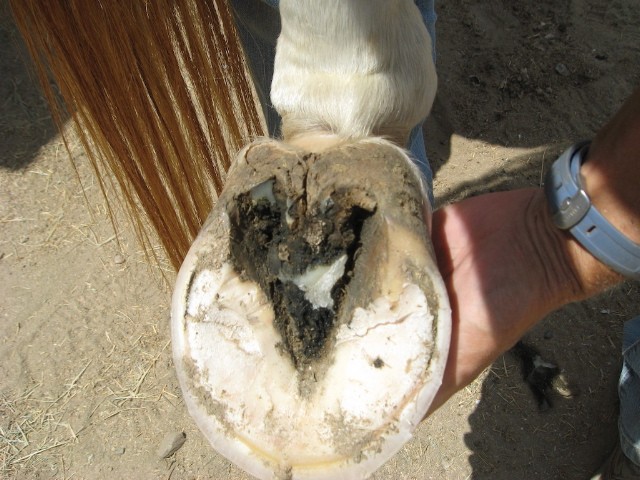Acute laminitis cases and other severe hoof problems aside, here are some good general guidelines for a non-invasive, basic barefoot trim.
Trim Wall to Live Sole Plane
As a general rule, bringing wall height within 1/8” to 1/16” of the live sole plane is a good guideline. Leaving that little bit of wall height will make all the difference in keeping the horse comfortable.
There are many times it simply won’t be that easy. Horses with a lot of sole that’s nearly ready to shed, for example, can usually be trimmed level with the existing sole plane; that way you aren’t leaving the hoof capsule too long once that sole sheds out. In some cases, bringing the heels to live sole + 1/8th” is too short; horses with really unhealthy frogs, for example, will usually do better with a bit more heel until the frogs are healthy again. Likewise, some horses with severe heel contraction may need a bit more while the foot is allowed to relax.
Once you’ve established wall height, you’ll apply your bevel, or mustang roll. A good rule of thumb is to keep the bevel of the wall the same width from the edge of the sole plane around the foot. If the wall is well attached, with no white line separation, you’ll simply leave the wall the same width from quarter to quarter. If the horse has separation at the quarters, but not at the toe, the wall will be more aggressively beveled through the quarters, less so at the toe.

A spectacular hoof. This foot needed nothing more than the wall trimmed. Because of the excellent sole, and a robust frog, the wall can be trimmed almost level to sole plane.
Don’t Touch Sole
This is, in most cases, a safe and prudent rule. A more accurate statement, though, might be “don’t touch the sole until you’ve learned to distinguish between live sole, exfoliating sole, and retained sole.”
Live sole has a waxy appearance that’s hard to miss once you’ve seen it. Exfoliating sole is either chalky, coming off easily with your hoof pick, or has cracks and edges that look like they can be peeled away. Retained sole is often very smooth, and frequently fuses with the frog.
The best advice here is, if you’re not sure, don’t remove it. But rest easy in the knowledge that if it’s not ready to go, it will be quite difficult to remove. If it chips or flakes out easily, don’t be afraid to exfoliate it – gently. You’ll then be better able to gauge appropriate wall height and heel height.

This is another very healthy foot, but in this case, there was a layer of sole ready to be exfoliated. I’d leave a tad more wall height after paring out sole like this.
Don’t Trim Frog
Overtrimming the frog is detrimental. But not trimming the frog at all isn’t always the best approach. A diseased frog, with fissures and crevices and a general swiss-cheesy appearance, should be trimmed to remove unhealthy tissue.

This very compromised frog should be cleaned up with a hoof knife until no more flaps or black material are evident.
An excessively overgrown frog can make it difficult to gauge collateral groove depth, and heel height. It’s a common rooky mistake to trim the heels to existing frog height, instead of to live sole.
Developing a better eye for a healthy frog will help you decide when to pare the frog, and when to leave it alone. It is always a good idea to clean up and open the central sulcus.
Trim to Tight White Line
I threw this one in here because this was what I was taught when I was first learning to trim, and boy, is it a scary idea! ALWAYS use the sole as your guide. Only in very extreme situations is it necessary or remotely prudent to bring the wall shorter than the live sole plane, and even then, it should be done only by an experienced hoof care provider!
Hairline/Dorsal Angle/Heel Angle Parameters
There are some very disparate ideas out there regarding ideal hairline angle, dorsal angle, and heel height. There are some relevant studies on the subject, and my personal opinion based upon those studies, as well as the hooves I’ve rehabbed over the years, differs quite dramatically with some of the parameters being preached by a number of different hoof trimming schools. But I think it’s sufficient to say that NO hoof should be trimmed with the immediate goal of an ideal. Learning to read the hoof, and apply the right trim for that foot at that point in time, will never let you down. Ultimately, if you trim a lot of horses, you’ll begin to see a remarkable consistency in the healthiest feet, and from that, I would encourage you to form your opinion on the subject of ideal angles.
Finally, always be wary of the word “always”. If the protocol you’re trying to apply makes strict assertions that a particular element of the trim should be applied to every foot, remind yourself that every foot is very different, and should absolutely be trimmed with that in mind. And as always – if what you’re doing isn’t working, try something different!




